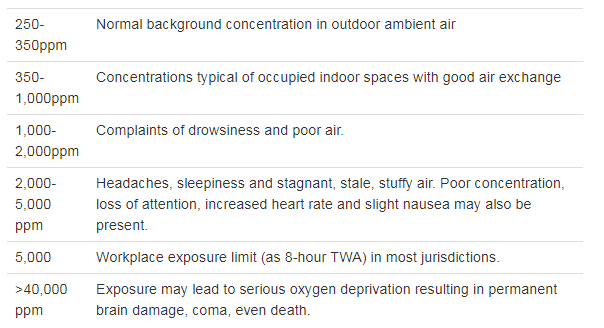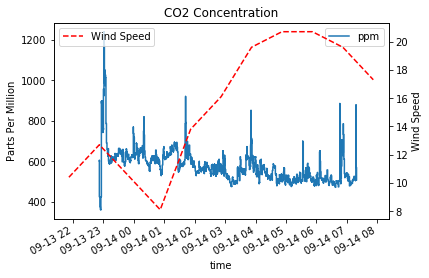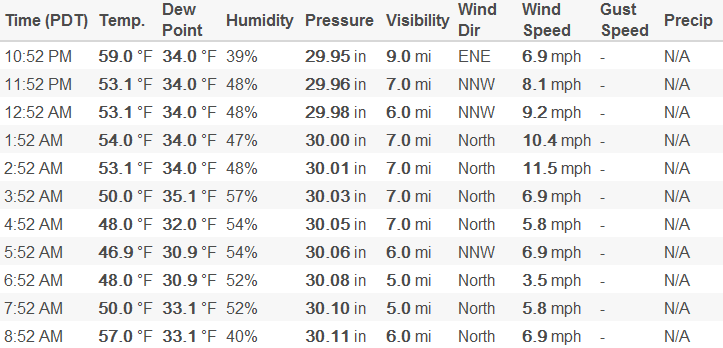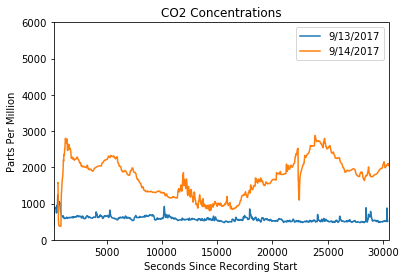It occasionally makes sense to sleep in a car. Sometimes it makes sense on a rainy night at a trail-head. Sometimes it makes sense for weeks on a road trip. Sometimes it makes sense because you can’t handle a morning commute tomorrow, so you commute to your office at night and sleep in the parking lot. Whatever the reason, its probably a good idea to make sure you wont be suffocating. Based on the water-tightness of the average car and lack of HVAC operation when off, I question the quality of the ventilation within. If ventilation is poor, and you spend all night in there breathing, maybe you run the risk of excessive carbon dioxide exposure. According to A Textbook of Biology:
The gas exhaled [by a person] is 4% to 5% by volume of carbon dioxide, about a 100 fold increase over the inhaled amount.
Is there a risk of excessive carbon dioxide exposure overnight? Does it matter? Lets take a look.
CO2 concentration levels in the air we breathe affect our cognitive function, and at high concentrations can be lethal. CO2 is a colorless and odorless gas. CO2 is heavier than air and can accumulate in low spaces causing oxygen deficiency[2].
Low Concentration Risks
Per the National Institute for Occupational Safety and Health, recommended exposure limit (time weighted average concentration for up to a 10-hour workday) is 5000ppm. The OSHA permissible exposure limit is listed at 5000ppm, also a time weighted average figure.
A Harvard University study[1] exposed the effects of CO2 concentration on cognitive function. The study generally shows that increased CO2 levels result in lower cognitive capability. This is the case even below 1000ppm. At 945ppm, participants saw a 15% cognitive test score reduction on average versus a 600ppm CO2 environment. The study link is included in the reference.
High Concentration Risks
Carbon Dioxide poses health risks if inhaled at high concentrations for prolonged periods of time. The higher the concentration, the less exposure time required to cause significant adverse health effects. Symptoms include dizziness, headache, elevated blood pressure, increased heart rate, suffocation, and unconsciousness.[2]
The following table describes the health effects of various concentrations:

It appears that the level of carbon dioxide concentration in the air we breathe does matter. Lets see how bad the situation is in the car.
Test Setup
The following equipment was used for this test:
| CO2 Sensor | Vaisala GMP252 |
| Data Logging PC | Lenovo Thinkpad |
I don’t just have a CO2 sensor on hand, and I certainly wasn’t going to pay for one. I came across one a coworker was using for a project at work. The Vaisala GMP252 CO2 sensor was connected to the PC via USB and serial communication was logged and saved on the PC in a text file.
The CO2 sensor was placed within proximity to my head, and on the same horizontal plane to attempt to get an accurate reading of the CO2 concentration throughout the night. It was also placed in such a way that I would not directly exhale onto the sensor. See appendix for test setup image.
The Vaisala GMP252 is an appropriate sensor for this test due to its high accuracy between 0 and 10,000 ppm, results are expected to lie entirely within this range. The sensor is also capable of higher concentration measurements with less accuracy. The following table describes the sensor performance specifications:

Test Conditions
The test was run at location 47.1884 N, -119.3241 W, a parking lot at Grant County International Airport in Moses Lake, Washington on the night of August 13th. The following table describes the weather conditions as measured by the airport weather station during the testing:

Initially the sensor was held outside of the vehicle in ambient conditions to develop a baseline CO2 concentration of the ambient air. The results show an ambient CO2 concentration of 360ppm. The following plot shows all measurements obtained during the test along with the hourly wind speed.

Due to the high wind speeds, it is likely that the test environment was not conservative enough. CO2 concentrations may reach much higher levels on a more still night due to less air mixing. Peaks may be due to me exhaling towards the sensor.
To represent a more conservative test environment, I ran an additional test on the night of August 14th. During this test, I attempted to reduce the interiors exposure to the ambient air. I completed this by closing two of the four windows that are generally left open 1 inch from the upper window seal. This configuration represents a more conservative vehicle configuration than I ever use in practice. The vehicles position and configuration was the same otherwise.
The following table presents the weather conditions for the August 14th test environment.

Significantly lower wind speeds, and a ten-degree temperature drop were measured on the night of the 14th. Otherwise, weather conditions were like the 13th.
Again, the sensor was held outside of the vehicle to develop a baseline ambient air CO2 concentration. The results show an ambient CO2 concentration of 370ppm. The following plot depicts a comparison of the two nights of recording.

Results & Conclusion
Based on the two days of data, vehicle configuration and weather have an impact on the CO2 concentration inside the vehicle. It is unclear how significant either is. The test goal, restated here:
The purpose of this test is to determine whether the levels of carbon dioxide concentration in my car overnight stay within safe levels while I am asleep inside.
was achieved. The data from the night of August 14th shows that even with an extremely conservative vehicle configuration, CO2 concentrations stay below 5000ppm, the time weighted average exposure limit[2] for a ten-hour period. The data also shows that it is worthwhile to maximize the air mixing as much as possible to maintain low CO2 concentrations inside. In practice, this means that all windows are open as much as possible, in my case, this is constrained by external variables. The data from the night of August 13th also shows that in a more standard vehicle configuration, albeit with high winds, the CO2 concentration is well within comfortable limits.
Additional Data
After understanding the CO2 concentration risks regarding cognitive function, I also tested the CO2 concentration of my office environment. The results are shown below:

At around 9AM, a coworker sat very close to the sensor, and may have been exhaling in the direction of the sensor on occasion. The rise in CO2 concentration with their presence is clearly shown on the above plot.
The data shows CO2 levels are relatively low in my office environment. These levels are roughly on par with the baseline “green” condition in the Harvard study[1].
Appendix
Test Setup Image:

References
- Allen JG, MacNaughton P, Satish U, Santanam S, Vallarino J, Spengler JD. 2016. Associations of cognitive function scores with carbon dioxide, ventilation, and volatile organic compound exposures in office workers: a controlled exposure study of green and conventional office environments. Environ Health Perspect 124:805–812; http://dx.doi.org/10.1289/ehp.1510037
- Center for Disease Control and Prevention & The National Institute for Occupational Health and Safety https://www.cdc.gov/niosh/ipcsneng/neng0021.html
- http://www.engineeringtoolbox.com/co2-comfort-level-d_1024.html
Excellent report thank you so much I’m going to go sleep in my car
Hi Joe. I am not sure the results of my setup generalize well to yours. Luckily, CO2 suffocation is very noticeable, so you may not reach life threatening levels without a severe headache, panicking and hyperventilating.